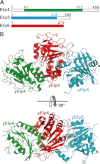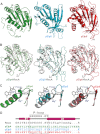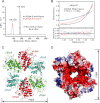Crystal structure of elongator subcomplex Elp4-6
- PMID: 22556426
- PMCID: PMC3375571
- DOI: 10.1074/jbc.M112.341560
Crystal structure of elongator subcomplex Elp4-6
Abstract
Elongator is a multiprotein complex composed of two subcomplexes, Elp1-3 and Elp4-6. Elongator is highly conserved between yeast and humans and plays an important role in RNA polymerase II-mediated transcriptional elongation and many other processes, including cytoskeleton organization, exocytosis, and tRNA modification. Here, we determined the crystal structure of the Elp4-6 subcomplex of yeast. The overall structure of Elp4-6 revealed that Elp6 acts as a bridge to assemble Elp4 and Elp5. Detailed structural and sequence analyses revealed that each subunit in the Elp4-6 subcomplex forms a RecA-ATPase-like fold, although it lacks the key sequence signature of ATPases. Site-directed mutagenesis and biochemical analyses indicated that the Elp4-6 subcomplex can assemble into a hexameric ring-shaped structure in vitro and in vivo. Furthermore, GST pulldown assays showed that the ring-shaped assembly of the Elp4-6 subcomplex is important for its specific histone H3 binding. Our results may shed light on the substrate recognition and assembly of the holo-Elongator complex.
Figures





Similar articles
-
DERP6 (ELP5) and C3ORF75 (ELP6) regulate tumorigenicity and migration of melanoma cells as subunits of Elongator.J Biol Chem. 2012 Sep 21;287(39):32535-45. doi: 10.1074/jbc.M112.402727. Epub 2012 Aug 1. J Biol Chem. 2012. PMID: 22854966 Free PMC article.
-
The Elongator subcomplex Elp456 is a hexameric RecA-like ATPase.Nat Struct Mol Biol. 2012 Feb 19;19(3):314-20. doi: 10.1038/nsmb.2234. Nat Struct Mol Biol. 2012. PMID: 22343726
-
Evolutionary Conservation in Protein-Protein Interactions and Structures of the Elongator Sub-Complex ELP456 from Arabidopsis and Yeast.Int J Mol Sci. 2024 Apr 15;25(8):4370. doi: 10.3390/ijms25084370. Int J Mol Sci. 2024. PMID: 38673955 Free PMC article.
-
Structural insights into the function of Elongator.Cell Mol Life Sci. 2018 May;75(9):1613-1622. doi: 10.1007/s00018-018-2747-6. Epub 2018 Jan 13. Cell Mol Life Sci. 2018. PMID: 29332244 Free PMC article. Review.
-
Structures and Activities of the Elongator Complex and Its Cofactors.Enzymes. 2017;41:117-149. doi: 10.1016/bs.enz.2017.03.001. Epub 2017 Apr 12. Enzymes. 2017. PMID: 28601220 Review.
Cited by
-
Architecture of the yeast Elongator complex.EMBO Rep. 2017 Feb;18(2):264-279. doi: 10.15252/embr.201643353. Epub 2016 Dec 14. EMBO Rep. 2017. PMID: 27974378 Free PMC article.
-
Wheat Elongator Subunit 4 Negatively Regulates Freezing Tolerance by Regulating Ethylene Accumulation.Int J Mol Sci. 2022 Jul 11;23(14):7634. doi: 10.3390/ijms23147634. Int J Mol Sci. 2022. PMID: 35886984 Free PMC article.
-
Molecular architecture of the yeast Elongator complex reveals an unexpected asymmetric subunit arrangement.EMBO Rep. 2017 Feb;18(2):280-291. doi: 10.15252/embr.201642548. Epub 2016 Nov 21. EMBO Rep. 2017. PMID: 27872205 Free PMC article.
-
DERP6 (ELP5) and C3ORF75 (ELP6) regulate tumorigenicity and migration of melanoma cells as subunits of Elongator.J Biol Chem. 2012 Sep 21;287(39):32535-45. doi: 10.1074/jbc.M112.402727. Epub 2012 Aug 1. J Biol Chem. 2012. PMID: 22854966 Free PMC article.
-
Dimerization of elongator protein 1 is essential for Elongator complex assembly.Proc Natl Acad Sci U S A. 2015 Aug 25;112(34):10697-702. doi: 10.1073/pnas.1502597112. Epub 2015 Aug 10. Proc Natl Acad Sci U S A. 2015. PMID: 26261306 Free PMC article.
References
-
- Shilatifard A., Conaway R. C., Conaway J. W. (2003) The RNA polymerase II elongation complex. Annu. Rev. Biochem. 72, 693–715 - PubMed
-
- Selth L. A., Sigurdsson S., Svejstrup J. Q. (2010) Transcript elongation by RNA polymerase II. Annu. Rev. Biochem. 79, 271–293 - PubMed
-
- Li B., Carey M., Workman J. L. (2007) The role of chromatin during transcription. Cell 128, 707–719 - PubMed
-
- Clapier C. R., Cairns B. R. (2009) The biology of chromatin remodeling complexes. Annu. Rev. Biochem. 78, 273–304 - PubMed
Publication types
MeSH terms
Substances
Associated data
- Actions
LinkOut - more resources
Full Text Sources
Molecular Biology Databases
Research Materials

